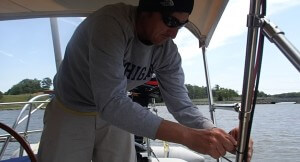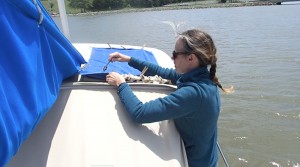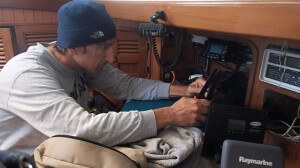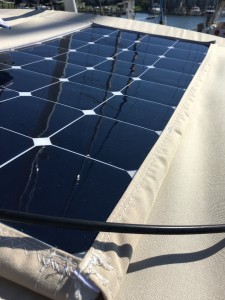We have been talking about getting solar for some time. However, we wanted to get comfortable with our energy needs aboard Bear and learn something of her electrical system before we dove into purchasing and installing some charging system that was not right for us. After two years, we were more than ready for some solar, but we were still not sure we knew exactly what our system would be like in the end. So, we decided to start with a simple and relatively inexpensive 80-100 watt package, including panel and charger, and continue to build and configure from there. With Margaret doing most of the research, we settled on a Go Power! GP30 100 watt package, which we picked up from Defender for about 650 dollars (for more about installing this system, see our post here).
I should start off by saying that I know very little about marine electrical stuff. The entire process of installing the solar charger taught us a lot about our electrical system and also pushed our meager skills and knowledge to the very limit. Now, we are enjoying a little more energy aboard and delighting in watching the amps go into the battery on the LCD display. We are also already thinking about how we will expand our charging system and change some of our other gear to better meet our energy needs in the future.
We now realize that in the future we will want a more functional solar (and possibly wind) charge controller than we have. Our battery setup is a bit odd in that we have two 8D AGM batteries as our house bank. We use the number one battery as our starting battery and, thus, have a battery switch that allows us to run off one or the other battery or both in parallel. Ideally, we would like our controller to charge both batteries at the same time, which is not possible with the controller that comes with the Go Power! system unless we kept the two batteries in parallel all the time, which we find unacceptable. Instead, we wired the controller solely to the number two battery, which we typically (though far from always) isolate and run as the main house battery when we are at anchor, leaving the number one in reserve. With some additional wire, we could hook up our number one to the controller as well, but the controller would only charge that battery when the number one was topped off.
Over the rest of the summer, we will continue to pay attention to both our current energy deficit with the solar charger and the amount of amp hours we would ideally like to have each day aboard Bear. Over the first two days with the solar panel, we have averaged about a 5.2 amp yield from 10am until 3pm and some fraction of that during the rest of the daylight hours. This turns out to somewhere in the neighborhood of 40 amps over the course of a sunny day. However, we have already noticed that the amount varies depending on how much shade the panel sees over the course of the day. For instance, yesterday we had a long period in the heart of the early afternoon where we were only yielding in the low 4s because the boom was partially shading the panel.

Trying to make the ugly wires as inconspicuous as possible. We will be feeding them through the bimini support in the future.
Going forward, we will definitely want to at least double our energy production at anchor, which could be met simply by adding another panel. However, we will probably increase our energy usage in some ways as we have access to more power. For instance, today Margaret and I went in to shore to use our Dremel for about a hour. Perhaps in the future we would want, need, or expect to do that work using the inverter. On the flip side, our biggest energy draw (an astounding 18 amps!) on the boat, by far, is our Combi-Cold refrigerator. While a new reefer will run us in the neighborhood of 2500 dollars, it will purr along constantly at, on average, maybe two amps. While the cost-benefit analysis suggests we might be better just keeping our current refrigerator and taking the money we would have spent on replacing it to add additional solar or wind, we are both more keen on efficiency rather than generation even if it is more expensive. And, in addition to the refrig, there are still a few more low-hanging energy savings that we can and will make over the next couple months.
In the end, we still have a lot more to learn about how our energy usage will develop as we move towards more full-time cruising. And, we will surely gain more knowledge about both our electrical system and our options for energy savings and energy generation. But you will probably be seeing another solar panel and a new charge controller on Bear sooner rather than later.




Wow! 18 Amps!
I thought my fridge unit was high at 5.5Amps for an old Cold Machine. Just slightly more than the VHF in Transmit.
Solar is good. Nice to stay off-grid and not have to run the engine to recharge the batteries. I’ve been looking at solar myself.
Yeah, 18 AMPs is killer, and slightly unbelievable. If the fridge ran at 18 AMPS for say 3/4 of the day (18 hrs), you’d be at 324 AMP/HRs in a day for that one item! Would love to hear more.
We are trying to remedy our fridge, which runs about 4.5 AMPS for about 20 hours a day, and a major draw on our brand new vessel.
When we were hooked up to shore power, we found that our fridge was really only on about half the time. So, averaged over a day, it was only about 200 amps, which is, obviously, still way too much. We run our fridge for at least two 30-40 minute periods every day along with the entire time we are motoring. We find that this and an occasional bag of ice, keeps everything in there fresh. However, if we miss one of the turn-ons, we are always in danger of losing everything, especially if we do not have a lot of canned beverages in there that sort of work as a cold reservoir.
Let us know what you end up coming up with on your boat. What kind of boat is it?
I know, 18 amps is crazy. We would be over the moon if our refrig was just drawing 5.5!
New follower. I gotta say I am loving your feed!
We’ve just bought or first sailboat (and living aboard too!) and are working on getting it up to snuff. I found you in YouTube researching replacing a sink in my galley and I am a fan!
This prolly won’t be our blue water cruiser, but we hope to be cruising in a few years nonetheless. It’s fascinating to see you living or dream!!
You can check out our YouTube channel by searching for “sailures.”
We’ve only got 4 episodes, but we’re just getting started!
Thanks for the help, notification, and inspiration.
Thanks, Scott. We will be sure to check out your channel in the fall; we do not watch much of any video while we are on the boat during the summer…too much bandwidth and not enough time. Good luck with the new boat!
Are you in the salt pond? Without a doubt I see you guys. We’re anchored north of you, one boat over on Penrose.
Hello Don. Indeed we are here in the Salt Pond. We can see you just a few boats over in what looks to be a beautiful boat. We will stop by to say hello later today (or feel free to come by yourself). Thanks for contacting us and enjoy the weekend.
Great! I winter at Branford Landing and I always eyed Bear in the yard. Couldn’t believe when she was listed and sold before I could act! Talk to you soon.